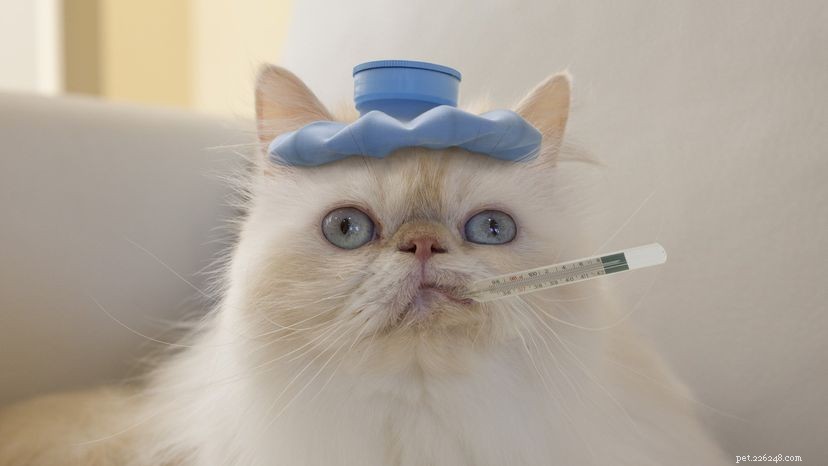 Apprendre à repérer et traiter une maladie de votre chat peut contribuer à assurer une vie longue et heureuse. Voir plus images de chat .
Apprendre à repérer et traiter une maladie de votre chat peut contribuer à assurer une vie longue et heureuse. Voir plus images de chat .
Certaines personnes pensent que les animaux sont porteurs de toutes sortes de maladies dangereuses. Certaines de ces craintes sont fondées, en particulier chez les animaux sauvages ou exotiques. Mais la vérité est qu'il n'y a pas beaucoup de maladies graves que vous pouvez attraper d'un animal domestique - et surtout pas d'un animal de compagnie. Sinon, ça ne ferait pas de très bons animaux de compagnie, n'est-ce pas ? Il existe cependant certaines maladies qui peuvent être très graves pour votre chat. Dans cet article, nous passerons en revue et fournirons un traitement pour diverses maladies des chats dans les sections suivantes :
Notions de base sur les maladies du chat

Avant d'aller plus loin, il y a quelques mythes à dissiper. Il y a quelques maladies de chat qui ont des noms qui sonnent un peu trop près pour le confort de certaines maladies humaines très graves. Le virus de la leucémie féline (FeLV) provoque la leucémie... chez les chats et uniquement chez les chats. Le FeLV ne cause pas de leucémie chez les humains et il ne peut même pas vivre dans le corps humain. Il n'y a aucun danger qu'un chat FeLV-positif rende son maître malade.
Le virus de l'immunodéficience féline (FIV) ressemble beaucoup au virus de l'immunodéficience humaine (VIH), le virus associé au SIDA. Ce n'est pas une coïncidence :le FIV et le VIH appartiennent à la même classe de virus, mais c'est là que s'arrêtent les similitudes. Le FIV n'infecte pas les gens et ne peut pas causer le SIDA chez l'homme. Certaines personnes – et même certains vétérinaires – appellent le FIV « SIDA félin » comme un moyen rapide de décrire ce que fait le virus. Malheureusement, le nom ne fait qu'ajouter à la confusion. Le SIDA est une maladie humaine et le FIV est une maladie du chat.
Il n'y a également pratiquement aucune chance que le rhume de votre chat vous soit transmis - ou, d'ailleurs, que votre rhume lui soit transmis. Les virus qui provoquent généralement des éternuements, de la toux et un écoulement nasal et oculaire chez les chats n'infectent pas les humains.
Les chats peuvent contracter certaines des mêmes maladies que les humains :diabète, arthrite, maladies cardiaques et cancer, pour n'en citer que quelques-unes. Mais comme aucune de ces maladies n'est contagieuse, vous ne pouvez pas les attraper de votre chat.
Généralement, les chats sont considérés comme moins dangereux que les chiens (on ne voit pas à la une des articles sur un Siamois vicieux qui a mordu le bras d'un pauvre livreur), et leur réputation de propreté donne l'impression qu'ils ne portent pas maladies du tout. Mais en fait, la plupart des vétérinaires préfèrent affronter un chien en colère plutôt qu'un chat en colère. (Les chats peuvent vous mordre et vous couper avec les quatre pieds.) Et il y a quelques choses que vous pouvez attraper de votre chat. Voici quelques-unes des maladies homme-chat que vous devriez connaître :
Puces. Ces petits insectes robustes piquent les animaux à sang chaud et utilisent leur sang pour se nourrir. Les puces sont si minuscules qu'une seule piqûre est à peine perceptible (sauf si vous ou votre chat êtes allergique, auquel cas ça démange comme un fou). Cependant, une infestation de puces à part entière peut prendre tellement de sang d'un animal qu'il devient anémique.
Heureusement pour nous, les puces préfèrent la température corporelle plus chaude des chats et des chiens à nos 98,6 degrés Fahrenheit. Mais une puce affamée prendra n'importe quel port lors d'une tempête, et une puce sautera d'un chat infecté sur des tapis, des rideaux, des meubles, et plus tard sur vous pour une collation rapide.
On craint que les maladies véhiculées par le sang puissent être transmises par les puces, mais cela signifierait que la puce qui vous pique aurait dû mordre une autre personne atteinte d'une maladie transmissible par le sang, ce qui est possible mais hautement improbable. Les plus grands dangers des puces sont la gêne et les démangeaisons des piqûres.
Tiques. Ce sont aussi des insectes suceurs de sang. Les tiques sont un peu plus grosses que les puces, surtout une fois qu'elles se sont attachées à un hôte et qu'elles ont gonflé. Comme les puces, les tiques ne sont pas aussi susceptibles d'abandonner votre chat pour vous, mais cela peut arriver. De plus, si votre chat est allé quelque part où les tiques traînent, il y a de fortes chances que vous y soyez allé aussi ou que votre chat les ait ramenées à la maison. Encore une fois, le problème le plus courant est la gêne. Cependant, les tiques peuvent être porteuses de deux maladies graves :la fièvre pourprée des montagnes Rocheuses et la maladie de Lyme.
La meilleure protection contre ces deux maladies est l'élimination rapide et complète des tiques. Quelques générations de scouts ont appris que la meilleure façon d'enlever une tique est de brûler sa chatte avec une cigarette ou une tête d'allumette fumante. Eh bien, outre le fait que les Boy Scouts ne devraient pas fumer, la stratégie d'expulsion du feu n'est pas le meilleur choix.
La meilleure façon d'enlever une tique est d'utiliser une pince à épiler pour saisir la tique le plus près possible de la peau. Tirez-le tout droit, fermement mais doucement, avec une pression lente et uniforme. Cela devrait supprimer toute la tique, y compris la tête. Les tiques sont très résistantes, alors déposez-les dans une petite bouteille d'alcool à friction pour vous assurer qu'elles sont mortes (et pour les conserver pour votre vétérinaire, si votre chat montre des signes de maladie). Ensuite, une fois que vous avez retiré la tique, tamponnez la zone avec un antiseptique topique ou une pommade antibiotique.
Vers. Ces petits bonhommes peuvent vivre dans votre tube digestif sans que vous vous rendiez compte qu'ils ont élu domicile. Les vers peuvent être attrapés par une manipulation négligente des bacs à litière et de la terre que les chats ont utilisée comme bac à litière. Les enfants courent un risque particulier d'attraper des vers de cette façon.
Les vers sont souvent difficiles à détecter, car ils vivent à l'intérieur du corps. La dénonciation est généralement une sorte de problème digestif qui ne disparaît pas et n'a pas d'autre explication. C'est aussi une bonne idée d'apporter un échantillon des selles de votre animal chez le vétérinaire pour un examen microscopique des vers et des œufs de vers. Les vers peuvent être traités rapidement et en toute sécurité dès qu'ils sont diagnostiqués.
La teigne. Ce n'est pas vraiment un ver du tout. C'est un champignon qui s'installe sur la peau, provoquant des plaques chauves et squameuses généralement bordées d'un anneau rouge. Les chats sont connus pour être des porteurs asymptomatiques de la teigne, ce qui signifie simplement qu'ils peuvent transporter le champignon dans votre maison (et sur vous) sans jamais montrer de signes eux-mêmes. Bien sûr, de nombreux chats montrent aussi des signes.
Que votre chat montre les signes ou que vous en ayez (ou que vous en ayez tous les deux), vous devrez très probablement traiter toute la maison, ainsi que tous les chats de la maison. Les spores de la teigne peuvent survivre dans les coins et recoins de votre maison pendant des mois. Les traitements peuvent inclure la désinfection de votre maison, des onguents ou des lotions topiques pour les plaques squameuses, des trempettes ou des bains pour votre chat et des médicaments oraux.
Rage. C'est une affaire sérieuse. La rage est une maladie mortelle. De plus, une fois que la maladie s'est installée, il n'y a pas grand-chose à faire pour l'arrêter. La meilleure défense contre la rage est une attaque puissante. Un chat d'intérieur n'a presque aucune chance d'être exposé à la rage, mais le pari le plus sûr est de donner à votre chat un vaccin contre la rage et de le maintenir à jour. La rage se transmet par la morsure ou la griffure d'un animal infecté, donc chaque fois qu'un chat d'extérieur se frotte contre un autre chat ou s'emmêle avec la faune locale, il y a une chance qu'il le contracte.
La rage infecte tous les animaux à sang chaud, y compris les humains. Toute morsure ou égratignure d'un animal - même un que vous connaissez et qui est à jour avec ses vaccins contre la rage - doit être considérée comme potentiellement dangereuse. Ce n'est jamais une réaction excessive de consulter un médecin pour une morsure de chat ou une grave griffure de chat.

Maladie des griffes du chat (également appelée fièvre des griffes du chat). Certaines personnes insistent sur le fait que la fièvre des griffes du chat est un mythe, mais c'est vraiment une maladie médicalement prouvée. Les griffures et les morsures de chat peuvent se transformer en infections graves du jour au lendemain. Les morsures de chat, en particulier, nécessitent une attention particulière. Lavez soigneusement les morsures ou les égratignures graves et appelez votre médecin pour obtenir des conseils. Vous pourriez avoir besoin d'un rappel contre le tétanos ou d'une injection d'antibiotiques pour prévenir l'infection.
Toxoplasmose. Toxoplasma gondii est un parasite protozoaire (organisme unicellulaire) qui peut provoquer une maladie neurologique chez l'homme. Ce protozoaire est transmis dans les selles des chats infectés, qui à leur tour l'attrapent des animaux infectés qu'ils ont tués et mangés. Les chats sont ce qu'on appelle le principal vecteur de l'organisme toxoplasme, ce qui signifie que le cycle de vie du parasite dépend du fait qu'il passe au moins un peu de temps dans le corps d'un chat.
Les chats ne présentent généralement pas beaucoup de symptômes lorsqu'ils sont infectés par la toxoplasmose - et une personne qui l'attrape ne le fait généralement pas non plus. Il peut y avoir des symptômes bénins qui se font passer pour un rhume ou une grippe, mais c'est généralement à peu près tout. Les deux principales exceptions sont les personnes dont le système immunitaire est affaibli (comme une personne sous chimiothérapie ou une personne atteinte du SIDA) et les femmes enceintes.
Peut-être que 70 % des adultes ont déjà été infectés par la toxoplasmose et sont maintenant immunisés. Bien que les chats soient le principal vecteur de ce parasite - et qu'il soit théoriquement possible de contracter la toxoplasmose par une manipulation négligente des bacs à litière ou par l'inhalation de spores de toxoplasme lors du nettoyage du bac à litière - la plupart des gens contractent la toxoplasmose en creusant dans la terre contaminée par des excréments de chat ou manipuler ou manger de la viande crue ou insuffisamment cuite.
Ce sont les maladies de base dont vous devez vous soucier. Dans la section suivante, nous vous montrerons les signes avant-coureurs indiquant que votre chat a contracté une maladie dangereuse.
Signes précoces de la maladie des chats

« Prévenu est prévenu », dit un bon vieil adage. En termes un peu moins fleuris, cela signifie simplement que si vous savez à quoi vous attendre - ou ce qu'il faut rechercher - vous serez mieux préparé à faire face à tout ce qui se présente à vous.
Nous pouvons dire si une personne se sent mal par son expression faciale... ou parce qu'elle fait partie de ces personnes qui aiment vous parler de chaque petit mal et douleur. Eh bien, la peau d'un chat est entièrement recouverte de fourrure, il n'a que quelques expressions faciales et il ne peut pas parler, c'est donc à vous de connaître les signes subtils - et pas si subtils - que quelque chose pourrait être tort.
Alertes précoces
Chaque fois que quelque chose ne va pas avec votre chat, il y a généralement des signes avant-coureurs. Malheureusement, les signes peuvent être si légers lorsqu'ils apparaissent pour la première fois que vous pouvez facilement les manquer. D'autres fois, vous remarquerez peut-être quelque chose d'un peu différent chez votre chat, mais il semble inoffensif et même mignon. Gardez à l'esprit que les signes avant-coureurs peuvent s'accumuler si lentement sur une si longue période qu'au moment où vous les remarquez, ils ne sont plus des avertissements précoces.
Quand vous avez un chat malade, rien n'est pire qu'un recul de 20/20 - ce sentiment terrible de ne rien voir venir alors que tous les signaux étaient là. Pour vous épargner tout cela, voici quelques éléments importants à surveiller :
Changements de comportement. Votre chat habituellement amical est-il devenu plus maussade, timide ou susceptible d'être caressé ces derniers temps ? Ou votre chat habituellement lunatique ou timide est-il devenu sensiblement plus amical ? Tout type de changement de personnalité chez un chat peut être le signe d'un problème de santé chez le chat.
De nouveaux comportements ou une fréquence accrue de comportements peuvent également être un avertissement précoce, comme un chat qui n'a jamais bu au robinet et qui apprend soudainement le tour ou un chat qui « démange » qui se gratte ou se frotte les oreilles plus souvent. De même, si votre chat semble avoir plus soif (boit plus souvent ou plus longtemps), il pourrait vous dire qu'il a un problème rénal, un diabète précoce ou simplement qu'il fait un peu trop sec dans la maison.
Vous voyez, il est important de souligner ici que ces avertissements comportementaux précoces ne sont que cela :des avertissements. Ils ne signifient pas nécessairement qu'il y a un problème sérieux avec votre chat, qu'il a quelque chose qui pourrait devenir un problème sérieux, ou même qu'il y a quelque chose qui ne va pas chez lui. Si vous détectez un signe avant-coureur, surveillez simplement votre chat de plus près pour voir si le signe avant-coureur persiste ou s'aggrave.
Appelez votre vétérinaire dès que possible et discutez de ce que vous avez vu. Votre vétérinaire peut vous suggérer de prendre rendez-vous pour un examen ou simplement poser quelques questions et vous donner d'autres indices à surveiller.
N'oubliez pas que tout type de changement de comportement peut être significatif, aussi léger ou sans importance qu'il puisse paraître. Être un bon observateur de chats vous aide non seulement à détecter les problèmes de santé émergents à un stade précoce, lorsqu'ils ont les meilleures chances d'être traités avec succès, mais cela peut aussi vous donner une meilleure appréciation du comportement magnifique et complexe des chats.
Changement d'apparence. Semble-t-il y avoir un peu moins de votre chat ces jours-ci ? Ou peut-être un peu plus ? En supposant que son régime alimentaire et son appétit soient les mêmes, un gain ou une perte de poids pourrait vous indiquer que quelque chose de potentiellement plus grave se passe dans le corps de votre chat. Ses cheveux semblent-ils plus fins ? Plus grossier ? A-t-il perdu son éclat sain? Un pelage terne, une perte excessive de poils ou une fourrure sèche, grossière ou cassante sont également des signes importants de problèmes de santé potentiels.
Bien sûr, les changements d'apparence sont naturels avec l'âge, y compris une certaine perte de masse corporelle ou une fourrure un peu plus négligée. Mais même ces changements normaux sont des signaux importants; ils disent que vous avez maintenant un chat âgé dont les besoins changeront avec son corps.
Modifications de l'appétit et de l'élimination. Les chats sont connus pour être des mangeurs difficiles. Mais, en fait, la caprice n'est pas vraiment une partie normale du comportement du chat. En général, les chats lèvent le nez sur la nourriture pour les trois mêmes raisons que les enfants :ça n'a pas bon goût; ils attendent quelque chose de mieux (et savent qu'ils l'obtiendront s'ils refusent ce qu'on leur a donné); ou ils ne se sentent pas bien.
Si votre chat mange régulièrement le même régime, puis perd soudainement son enthousiasme, ne présumez pas qu'il en a simplement marre de la même vieille nourriture. Si nous pouvons manger les mêmes céréales au petit-déjeuner ou prendre le même café et les mêmes viennoiseries tous les matins, il n'y a aucune raison pour que votre chat ne se contente pas du même menu tous les jours. Arrêter sa nourriture (ou, d'ailleurs, devenir affamé) est une autre façon pour votre chat de vous faire savoir qu'il ne se sent pas bien.
Étant donné que les chats utilisent le bac à litière, vous ne remarquerez peut-être pas tout de suite un changement dans les habitudes d'élimination. Aussi désagréable que cela puisse paraître, c'est une bonne idée d'être au moins conscient de ce que vous ramassez ou jetez de la litière du chat. Une augmentation ou une diminution marquée des urines ou des selles, la présence de sang ou de mucus, ou une odeur particulièrement piquante (lorsque la boîte a été récemment nettoyée) sont autant d'avertissements d'éventuels problèmes à venir.
De même, un chat qui est entraîné à la litière mais qui semble soudainement oublier vous envoie un message. Cela peut être dû au comportement, au stress ou à l'environnement, mais cela peut aussi être déclenché par des vers, une infection de la vessie ou d'autres problèmes potentiellement graves.
Il est souvent difficile de déterminer si un changement concerne strictement le comportement, l'apparence ou l'appétit et l'élimination. Par exemple, faire les cent pas sur le sol peut être considéré soit comme un changement de comportement, soit comme une indication d'hyperactivité de la glande thyroïde, et un chat qui a gratté des touffes de poils a un changement d'apparence qui pourrait provenir d'un changement de comportement. De plus, les changements peuvent se produire sur une période de plusieurs jours, semaines ou mois, ou ils peuvent simplement apparaître d'un moment à l'autre.
Les changements soudains ou brusques sont plus faciles à remarquer. Les changements à long terme s'additionnent au fil du temps, généralement si lentement que nous ne les captons pas tant qu'ils n'ont pas fait de progrès significatifs.
Revenons au diabète à titre d'exemple. Un chat qui développe un diabète boira plus et fera des voyages plus fréquents dans le bac à litière, produisant de plus grands volumes d'urine. Il serait presque impossible de remarquer que votre chat ne fait qu'un seul voyage supplémentaire vers le bol d'eau ou le bac à litière au cours d'une semaine, et ce serait toujours assez difficile même s'il était augmenté à un voyage supplémentaire chaque jour. Et même plusieurs voyages supplémentaires par jour peuvent également vous échapper, d'autant plus que les chats sont nocturnes et que la plupart des pauses supplémentaires pour l'eau ou la litière peuvent survenir pendant que vous dormez.
Au moment où vous pensez, "Bon sang, ce chat semble passer beaucoup de temps au bol d'eau ou à la litière", il est probablement au niveau de plusieurs voyages supplémentaires par jour. Vous devez vous entraîner à remarquer les habitudes quotidiennes de votre animal afin de pouvoir détecter et signaler tout changement subtil et progressif à votre vétérinaire.
Maintenant que vous avez remarqué un problème avec votre chat, vous devez maintenant décider s'il s'agit d'un problème que vous pouvez résoudre à la maison ou si vous avez besoin de l'aide de votre vétérinaire. Nous vous proposerons quelques conseils pour prendre cette décision dans la section suivante.
Quand appeler le vétérinaire

Bien sûr, les alertes précoces ne vous font aucun bien si vous ne faites rien à leur sujet. You should check out any indicators of potential health problems with your vet as soon as possible, just to be sure. But there are other times when a call to the vet -- or a trip straight to the animal hospital -- is a right-this-minute priority.
Any emergency situation. The common sense definition of a veterinary emergency is when you would call the doctor for yourself if it happened to you. Emergencies where you should take a cat to the vet would therefore include:
Any symptom that persists more than 48 hours or worsens (even a relatively mild one). Let's say you notice your cat has started sneezing a lot. It could be that she just crawled into a dusty nook somewhere, or it could be the start of a feline cold. If the sneezing doesn't go away after several hours, the cold begins to look like the more likely choice. If your cat is still sneezing a lot by the second day, it's pretty clear it's not going away by itself any time soon and it's time to call the vet.Of course, if any symptom worsens suddenly or interferes with your cat's breathing, eating, drinking, walking, or elimination, don't wait 48 hours. Call the vet immediately.Now that you know the fundamentals of cat disease, we will start to get into the particulars. We will begin in the next section with discussion of cats with asthma.
How to Treat Cats With Asthma

Asthma is a chronic breathing problem. Both cats and people suffer from it, but it isn't contagious. An asthmatic cat (or person) has bouts of extremely difficult breathing called asthma attacks. An asthma attack is fairly easy to spot; you'll notice rapid, open-mouthed breathing accompanied by wheezing and often by forced exhalations.
Because breathing is so severely restricted during an asthma attack, the cat's gums and tongue may take on a bluish color. (Do not try to give mouth-to-mouth resuscitation or CPR to a cat having an asthma attack.)
Asthma often develops from another breathing problem called allergic bronchitis. This is pretty much what it sounds like:The airways in the cat's lungs get inflamed as the result of an allergic reaction to inhaled germs, dust (including dust from litter), wood smoke, and other irritants.
Usually the cat has no other major signs of illness, a normal temperature, and continues to eat well. The only telltale sign is that she just has fits of deep, moist-sounding coughing. If the allergic bronchitis goes untreated or the source of the allergy isn't removed, the lungs can be permanently damaged, resulting in emphysema and asthma. Once the damage is done, even removing the original cause or causes of the allergic bronchitis won't make asthma go away.
Recently, some studies have been done on the effects of secondhand smoke on pets. The news is about what you'd expect:Secondhand smoke isn't particularly good for your cat. Cats with asthma or other breathing problems suffer more from secondhand smoke. Remember, asthma is related to allergies, so anything that irritates the air passages of the lungs -- including cigarette smoke -- can trigger an asthma attack.
What to Do
Reduce stress. Stress makes allergies and asthma worse. Right about now you're saying to yourself, "Stress? What the heck kind of stress does a cat have?" That's a fair question. They certainly don't have to worry about paying bills or where their next meal is coming from. (Those are your stresses, actually.) They don't have job pressures or deadlines to meet. Heck, they don't even have to think about what they're going to wear every day.
Cats have stress that we like to call "domestication stress" or "family stress." You see, cats weren't originally designed and built to live among humans. They've done a superb job of adapting, but no matter how independent and primal your cat seems, she's still having to deal with the human world and human civilization every single day. And that gets tough. Giving her plenty of options to do cat things such as run, climb, stalk (preferably another cat), bat things around, hide, and nap in secluded spots helps her cope.
If the stress level goes up in your life or in your household, it goes up in your cat's life, too. She can't understand why things are getting tense -- she just knows people are moving and sounding anxious. Remember, "stress" doesn't just mean negative things; positive events carry stress, too. In fact, probably the worst kind of stress for a cat is change.
A new baby, for instance, is not only a time for great joy but also for great change -- and the stresses that go with that. For you, those stresses mean less sleep (or none at all), a change in lifestyle, and an extra mouth to feed. For your cat, it means some strange new animal, who makes odd noises, smells funny, and doesn't do much, suddenly takes all the human attention away from her!
Clear the air. Secondhand smoke isn't the only thing that can make asthma worse. Even things that we think make our home more pleasant can be a no-no for a cat with bronchitis or asthma. Perfumes, room fresheners, deodorizers, and even scented litters or litter additives can trigger allergy and asthma attacks.
Likewise, the fumes from paints, cleaners, varnishes, and new carpeting are actually chemical irritants that create problems for the asthmatic cat. Use natural objects, such as flowers, eucalyptus sprigs, and fresh floral potpourri, to provide a fresh scent to a room instead of sprays or solids that contain chemicals. Use strong-smelling paints, stains, cleaners, and solvents in well-ventilated rooms, and keep the cat out until the smell goes away. And put out those smokes.
It's a good idea to use plain, natural, unscented litter and to stay away from deodorizers you add to the litter. Also the dust from the litter itself irritates the lungs and can cause attacks in asthmatic cats. Some natural litters -- like the ones made of recycled paper -- have virtually no dust at all. To cut down on dust from clay litters, pour them slowly, keeping the opening of the bag just a few inches from the litter box.
Wetter is better. Dry air dries out the lining of your cat's air passages, encouraging coughing and making your cat more vulnerable to infection and allergic reactions. Be sure to have a good humidifier going, especially in winter, during heating season, and in arid areas of the country. There's an added bonus to this remedy:You will also be less likely to have as many coughs, stuffy noses, and colds in the air if your home is kept properly moist.
Moderation in all things. A sedentary cat is more prone to health problems, but a cat who already has asthma can have a severe attack if she exerts herself too much. On the other hand, if she barely exerts at all, her breathing will be more labored because her heart and lungs aren't fit. Plus, she'll probably gain weight, and the heavier the cat, the more trouble she'll have with her asthma.
Stick to the right amount of a high-quality, healthy diet; cut out the snacks and treats; and make sure your cat stays active. Get her a feline playmate and a good supply of toys. Be certain to play with her yourself, but keep the play sessions short and low-impact.
When to Call the Vet
Any full-blown asthma attack is a medical emergency, which means your cat needs immediate veterinary medical care. Likewise, if your cat gasps for air, collapses, or turns blue in the gums and tongue, don't wait to take her to the animal hospital. Milder signs (such as noisy breath, occasional and intermittent wheezing or moist coughs, or slightly labored breathing after exertion) aren't emergencies, but you should get your cat to the vet as soon as possible. They could be caused by something other than allergies. And if it is bronchitis or the start of asthma, your vet may be able to give your cat medication that can prevent the danger and fright of a full-blown attack.
DANGER LEVEL: Dangerous; a severe asthma attack can be fatal.
In the next section, we will examine how to treat your cat if she has urinary tract disease.
How to Treat Cats With Cystitis

A cat's bladder can become inflamed because of infection or irritation. Cystitis most often happens as part of a collection of bladder and urinary problems commonly called feline urological syndrome (FUS) or feline lower urinary tract disease (FLUTD).
Attacks of cystitis or FUS (which includes cystitis, along with inflammation of the urinary tract and the formation of stones or sand in the bladder) are announced by bloody urine, frequent urination of small amounts, litter box accidents, spraying, excessive licking of the urinary opening, straining in the litter box, and possibly tenderness of the lower abdomen.
The pH of a cat's urine -- how acidic or alkaline it is -- has a lot to do with cystitis and FUS. If the cat's urine is alkaline, it's much easier for urinary crystals to form. These crystals in turn form gritty "sand" or small stones that irritate the lining of the bladder and can plug up the urinary opening in male cats, which is an extremely serious problem.
What to Do
Serious complications of cystitis and FUS show up most often in adult male cats. The first flare-up usually occurs when the cat is fairly young, and repeat bouts can pop up for the rest of his life. That having been said, don't think that just because you have an older or female cat that you're in the clear:Urinary tract problems can strike any cat.
Food for thought. Most experts agree that many factors, including diet, contribute to a cat's susceptibility to developing FUS. Plant-based cat foods tend to make a cat's urine more alkaline (higher pH), which encourages the formation of crystals and stones and is a more hospitable environment for bacteria. Some commercial dry cat foods seem to have the same effect on urinary pH. As a result, cats who develop cystitis or FUS should only eat dry foods recommended by a veterinarian or stick to prescription dry food specially formulated for cats with bladder problems.
Your vet may also suggest a urinary acidifier to add to your cat's diet, making sure the pH of his urine stays low enough to prevent bladder stones, or may recommend a special diet formulated to dissolve crystals or stones in the bladder.
Magnesium is an important trace nutrient that every cat needs. Unfortunately, some commercial cat foods provide it in a form that also encourages crystals to form in the cat's urine, which can lead to bladder stones and, which, in turn, can cause a urinary obstruction. A quality commercial canned food is usually relatively low in magnesium, easy to digest, produces more acidic urine, and provides more fluid intake.
Water, water everywhere. The body is an amazing thing:If it doesn't have enough of something it needs, it finds a way to get it. If a cat isn't drinking enough, his body will find a way to conserve and reclaim water. One way is by reabsorbing water from the urine, making it more concentrated. The urinary tract lining in cats that have already had a bout of cystitis or FUS is particularly sensitive, and concentrated urine can trigger additional attacks.
Make sure your cat has constant access to plenty of clean, fresh water. Watch for your cat's drinking preferences -- some favor a water faucet or even the toilet over a water bowl on the floor. It might seem odd or even a little bit disgusting, but it's probably a good idea to cater to his water-drinking whims, especially if the option is a flare-up of bladder disease.
Cats also get water from their food. The higher the moisture content in his diet, the more water he's getting -- even without drinking. A cat who eats canned food gets a lot of water with the meal and more as a result of breaking down the higher fat, higher energy ingredients that are in most wet foods.
Less stress. The "body-mind connection" works for cats just as well as it does for people. Country folks know that a healthy attitude toward life makes for a healthy body. Unfortunately, you can't explain that to your cat. Instead, it's up to you to minimize his stress and maximize his health.
Try to anticipate problems. Do you know a major change is coming up in your household? Whether it's a new baby, someone going off to college for the first time, a family vacation, or remodeling the kitchen, if you know it's coming it's best to either ease the cat into it slowly or expect an attack of urinary problems and take the necessary precautions.
You should have realistic expectations for your cat. Sure, cats are clever and agile and maybe even a little sneaky, but they're still cats. It's entirely possible that your cat understands everything you say and is just playing dumb or being obstinate.
However, it's equally possible that he's only learned how to get along in human society just well enough to find himself a comfortable situation and doesn't have a clue why you're so bent out of shape that he's been urinating in your beautiful potted plants instead of the convenient litter box you bought him.
Also, if a cat doesn't understand why he's being reprimanded, he stresses out. A stressed cat will announce his unhappiness with a change in behavior, often by elimination. And, to a cat, leaving it where you're sure to notice it -- where your personal smell is strongest -- is a great way to guarantee you'll get the message.
Finally, to lessen your cat's stress, try to stay cool yourself. Have you ever tried to enjoy a favorite activity and then had someone who was really, really intense about it right next to you? To cats, life in your home is basically one long stay at a resort hotel:The weather is always fine, everything is already paid for, you don't have to work, and you can eat, sleep, and play whenever you like.
If the humans in this little paradise are under stress, though, the vacation is suddenly over. Some of this may be cats' fabled sensitivity to people's emotions, but some of it certainly is a reaction to the changes in the way we humans move and speak when we're agitated.
Check the box. A clean litter box filled with the appropriate kind of litter must be available to the cat at all times. Using the litter box is not an instinctive behavior in cats; the instinct part is the action of digging in loose materials to bury their urine and feces (especially if there is a habit of using that spot or the very faint residual smell of elimination there). If something turns them off to the box (like it's too dirty, too perfumey, or too much trouble to get to), they'll either hold it too long (increasing bladder irritation and the risk of infection) or find another "toilet." Check your cat's litter box regularly, making sure it is clean and free of irritants.
When to Call the Vet
Cats with urinary tract problems will often deliberately urinate outside of the litter box, even if they've been 100 percent accurate all their lives. If your cat suddenly starts having "accidents," spraying urine, or squatting and straining outside of the box, don't punish him. He's probably telling you he's got a problem. Call the vet as soon as you notice one of these signals and schedule an appointment for an exam. If it's a physical problem, the sooner your catch it, the easier it will be to treat. If it's a purely behavioral thing, you can start correcting it before it becomes an ingrained habit.
If your cat is straining in the litter box (or elsewhere) and not producing any urine, produces small amounts of bloody urine, or cries during urination, call the vet immediately. These are the signs of a urinary blockage, an extremely serious -- and potentially fatal -- problem.
DANGER LEVEL: Most bladder problems by themselves are not dangerous; they're mostly inconvenient and a nuisance for the owner. However, urinary blockage is extremely dangerous and should be treated as a life-threatening situation.
Next we will deal with a disease that is just as serious for cats as it is for humans -- diabetes.
How to Treat Cats With Diabetes

The pancreas is a long gland that lies directly beneath the stomach. A cluster of specialized cells in the pancreas produce insulin, which regulates the body's uptake and breakdown of sugar. Diabetes mellitus (usually just called diabetes or sugar diabetes) is the result of a shortage of insulin. Diabetics have intense thirst, produce large amounts of urine, and have abnormally high levels of sugar in their blood and urine. Other signs of diabetes are increased appetite and slow healing.
Left untreated, the diabetic cat will lose weight (despite eating more) and become lethargic. Later signs of untreated diabetes include vomiting, diarrhea, rapid breathing, weakness, and finally collapse and death.
Your vet's diagnosis of diabetes is based on the cat's clinical signs, physical exam findings, and laboratory test results, primarily a persistent presence of abnormally high levels of sugar in the blood and urine.
Diabetes is a disease of older cats, rarely occurring before the age of seven years. It can be managed through diet and, when necessary, supplementary insulin. With treatment, diabetic cats can live ordinary lives, and a few may return to normal function for reasons that are not well understood.
What to Do
Watch that weight. Obese cats are more likely to develop diabetes. In fact, cats who weigh in at 15 pounds or more have double the risk of diabetes than the under-15-pound crowd. Keeping your cat's weight under control is a simple formula:Feed only the recommended amounts, limit (or eliminate) snacks and treats, and make sure Tabby stays active.
You are what you eat. A high-fiber diet helps control diabetes by regulating the rate at which nutrients are taken into body cells. This, in turn, keeps blood sugar levels more consistent. Feeding several small meals during the day has a similar effect on blood sugar. A couple of large meals spread several hours apart cause a post-meal blood sugar surge, followed by a below-normal level by the time the next meal comes around. A normal cat's body smooths out these peaks and valleys, but it's a problem for diabetics. Many diabetic cats can have their blood sugar levels returned to normal through diet and weight loss alone.
Be prepared. One of the most important aspects of managing the health of a diabetic cat is consistency. Food and medication must come at regular times, so be sure you always have an adequate supply of both and never skip or substitute.
Occasionally, a diabetic cat on insulin will have her blood sugar level suddenly swing dangerously to the low side -- a condition known as hypoglycemia. Signs of hypoglycemia include shaking, disorientation, salivating, staggering and falling, and seizures. Keep an emergency sugar source on hand at all times (honey or Karo syrup are the usual recommendations). At the first sign of hypoglycemia, rub some on the cat's gums -- and call the vet immediately.
When to Call the Vet
If your cat shows signs of diabetes, schedule a veterinary exam as soon as possible. The longer a diabetic cat goes untreated, the more serious her condition gets. The earlier you can catch and control her diabetes, the more likely she is to have a normal life.
A cat who's already being treated for diabetes needs to go to the vet immediately if she shows signs of hypoglycemia or any kind of reaction to her medication.
DANGER LEVEL: Untreated diabetes and hypoglycemia are extremely dangerous; however, both can be treated and controlled.
While diabetes is a serious problem for cats, we will discuss an even more dire condition in our next section -- FIV, or what is commonly referred to as "feline AIDS."
How to Treat Cats With Feline Immunodeficiency Virus

FIV, FIP, and FeLV are three extremely serious, incurable, and usually fatal cat diseases caused by viruses. Each is caused by a different kind of virus. However, they are all contagious only between cats, and have the interesting quirk that not all cats exposed to them will get sick.
Unlike the viruses that cause upper respiratory diseases or distemper in cats and can be carried in the air, these three require the physical presence of an infected cat in the same place (although not necessarily at the same time) as the cat who catches it. FIP and FeLV are spread most often by prolonged close contact with an infected cat.
Close contact can include mutual grooming or sharing food, water, elimination areas, or sleeping quarters. This means a cat who goes outdoors and urinates or defecates where a cat carrying FIP or FeLV goes can catch the virus without ever having had physical contact with the carrier. FIP and FeLV can also be spread to kittens by a mother with the virus.
The main route of infection for FIV appears to be a bite from an infected cat. Cats who go outdoors -- particularly if they fight -- are therefore at risk. The most common profile of an FIV-positive cat is an unneutered male who goes outdoors and has sustained bites and scratches from other cats.
Cats who appear otherwise healthy may be carrying these viruses. Reliable blood tests exist for FeLV and FIV. There is a test for FIP; however, a positive FIP test alone -- without other symptoms or risk factors -- is not absolute proof the cat has the virus.
FIV is sometimes also called feline AIDS (or FAIDS). FIV does have a few general similarities to HIV, the virus associated with AIDS:It belongs to the same class of viruses, can stay in the body for years without causing illness, and when it becomes active, slowly breaks down the disease-fighting immune system. However, AIDS is a human disease, and FIV cannot infect humans.
What to Do
Take the test. Since a cat can appear healthy and still carry one of these viruses, a new arrival -- even your first cat -- should be tested for FeLV. Kittens probably don't need FIV tests unless they were strays, but it's probably a good idea to test adult cats from any source. Your veterinarian may recommend a retest in a few months. This isn't a scam; if your cat was very recently infected, it may not show up on the first test.
Stop the spread. There's only one surefire way to prevent your cat from contracting FeLV, FIP, or FIV:Keep her away from the sources of the viruses. In other words, keep her away from other cats and the places they frequent. This usually means keeping cats indoors at all times. It definitely means testing any new cat added to your household for FeLV and FIV before she's allowed to meet the resident cat or have run of any of the same areas. Preventative vaccines are available for FeLV and FIP. Schedule an appointment with your vet to talk about the advisability of vaccinating your cats for these diseases.
Be positive about positives. If your cat tests positive for FeLV or FIV and a retest confirms it, don't give up hope. With good care, FeLV- and FIV-positive cats can live for years, even after signs of disease appear. New treatments are coming all the time, and there may be a breakthrough that will help your cat long before she gets seriously ill.
Be responsible about the news. Keep your cat away from uninfected cats, and don't add any FeLV- or FIV-negative cats to your household. It may be tempting to start taking in other FeLV- and FIV-positive cats who are facing euthanasia, but think it over carefully. Eventually, the disease will catch up with them, and they'll demand a lot of time and resources. It may be best to focus on the special status of your own cat and give her the best possible quality of life.
Treat the symptoms. Most of what you can do for cats who are sick with FeLV, FIP, or FIV is just make them feel better. This might be as simple as indulging them with their favorite foods when their appetites are poor or coaxing them to eat with petting and hand-feeding. However, each virus has its signature complications that may also need attention, usually from the vet and with follow-up or nursing care at home. FeLV causes lymphosarcoma, a kind of cancerous tumor that may need to be removed.
The "wet" (effusive) form of FIP causes fluid to build up in the chest, making breathing difficult, or in the abdomen, giving the cat a bloated appearance. This buildup is a problem your vet can sometimes relieve by suctioning out the fluid with a needle and syringe. Since FIV attacks the immune system, you'll have to stay on top of secondary infections with prevention and medication.
When to Call the Vet
These three viral diseases are a strong case for annual veterinary checkups. The early signs of any of the diseases are often too subtle for the average cat owner to notice, but a veterinarian knows what to look for. In between checkups, notify your vet of any sudden abdominal bloating or swelling, low-grade signs of illness that never quite go away (sneezing or diarrhea, for example), any lumps on your cat's body, or bites or scratches from cats not known to be FeLV- and FIV-negative.
Cats who have been diagnosed with FeLV, FIP, or FIV should see the vet regularly.
DANGER LEVEL: All three of these diseases (FeLV, FIP, and FIV) are extremely dangerous. Although surprisingly few cats exposed to these viruses will get sick from them, once the illness begins it is almost always fatal.
Kidney disease in cats is not nearly as fatal as FIV, but it can still be quite serious. Learn more in the next section.
How to Treat Cats With Kidney Disease

The kidneys' major job is filtering out wastes. Age, injury, or disease can damage and destroy the function of kidney tissue. The body can adjust to minor kidney damage or the early stages of kidney failure, so there may be no noticeable signs at first.
As damage or failure worsens, a cat produces more urine and drinks more to compensate. In the later stages of failure, the kidneys can't keep up the pace, and wastes back up in the body, poisoning the cat and causing vomiting, loss of appetite, weight loss, and often telltale "ammonia breath."
Unfortunately, once kidney failure reaches this point, it's usually irreversible. The best way to detect a kidney problem is by a blood test. Mature cats and cats that show any signs of early kidney disease should be screened for kidney function.
What to Do
Kidney failure is sneaky. Many times, the symptoms are masked or completely invisible until the damage is critical. The typical cat in kidney failure has already lost about 70 percent of her kidney function by the time she's diagnosed.
Veterinarians sometimes talk about what is called "end-stage" kidney disease when things start getting that bad. This diagnosis is just what it sounds like. Treatment for end-stage kidney disease can prolong the cat's life and make her feel better, but the end is inevitable.
This doesn't mean that every cat showing signs of kidney trouble is doomed. Sometimes, an infection can set in and the kidneys will shut down. Quick treatment can stop the infection and get the cat back on her feet with very little long-term damage.
Watch for the signs. Do you notice your cat drinking more? Has she suddenly quit eating? Is she listless or depressed? Does she seem to be urinating a lot more or barely at all? Does she seem sore over the lower part of her back or sit in a hunched-up "pain crouch"? All of these -- along with vomiting and diarrhea -- are signs of a possible kidney problem or infection.
Get to the vet. Home care for cats with kidney problems is only follow-up care. You need a vet to diagnose the problem, start treatment, and possibly even hospitalize your cat until she's stable.
Do the right thing. You'll probably be given a very strict diet for your cat and possibly some medications. Follow your vet's instructions as if your cat's life depends on it -- because it does.
When to Call the Vet
You should call the vet immediately if any of the warning signs of kidney failure show up in your cat. Other problems have similar symptoms, and only a thorough exam and blood test can determine for sure that it's a kidney problem. The sooner you can catch it, the better the odds will be.
DANGER LEVEL: Kidney failure is extremely dangerous.
Another urinary tract problem that can significantly affect your cat's health is liver disease. We'll learn about the warning signs and symptoms in the next section.
How to Treat Cats With Liver Disease

The liver plays an important role in metabolism and taking toxins and other unneeded compounds out of the blood. Liver damage or disease can be the result of a birth defect, infections, poisoning, or other conditions such as heart disease.
Because liver problems are often part of other illnesses, they usually don't have unique symptoms of their own. The notable exception is jaundice, which is a yellowish cast to the white of the cat's eye and possibly even her skin and under her tongue. Usually, abnormal liver function is only discovered or verified through blood tests.
What to Do
Keep a sharp eye out. Liver problems due to infection and poisoning can often be stopped and much of the damage reversed if caught early enough. Watch for symptoms, and don't wait too long to call the vet if your cat is sick (especially if she's not getting better). Never assume any illness will get better by itself.
Since the clinical signs of a cat with liver problems are the same as several other illnesses it can be difficult to determine what's wrong with your cat. These signs include loss of appetite, vomiting, diarrhea, fever, weight loss, dehydration, seizures, and increased urination (thus increased water consumption). Once you notice these symptoms, check for any signs of jaundice to determine if the problem is liver-related.
Follow directions. Once a cat has been diagnosed with liver disease, her recovery depends on you. Carefully follow all diet and medication instructions your vet gives you. Resist the temptation to cheat in order to make your cat "feel better"; in the long run, you may be shortening her life.
When to Call the Vet
Jaundice is a sure sign that something is not normal in the liver, so call the vet immediately.
DANGER LEVEL: Liver disease is usually fatal if not treated, and some forms are fatal no matter what. Therefore, liver disease is extremely dangerous.
Your cat does not brush her teeth every night before bed, and, as a result, tooth and gum disease can be a problem. We'll cover how to care for your cat's choppers in the next section.
How to Treat Cats With Tooth and Gum Disease

Just like people, cats have a set of baby (deciduous) teeth when young, which are replaced by permanent teeth. Similarly, keeping the teeth and gums healthy requires regular preventative care. Food and saliva form plaque, which can mineralize into hard deposits of tartar.
Gingivitis (inflammation of the gums) and loss of permanent teeth can result. Actual cavities are relatively rare, but pitting and other tooth damage can result from neglecting oral hygiene. Mouth pain and tooth loss may reduce a cat's interest or ability to eat, causing weight loss and making the cat more prone to illness.
What to Do
Brush regularly. You don't need to have an actual toothbrush and paste, but giving your cat's teeth a good going-over a few times a week is the best way to fight plaque. There are pet toothbrushes available, but you can also just use a piece of gauze or rough cloth that is moistened and wrapped around your index finger. Rub the cloth vigorously over the outside surfaces of the teeth (you don't usually need to get the inner or biting surfaces). This will help keep your cat's teeth clean and gums healthy.
Give Tabby the crunchies. Hard, dry cat food is the best bet to prevent plaque and tartar. There are now some chew-toy products on the market made especially for cats, which can also help.
Look out for tartar. Plaque is a mushy whitish material that you can easily scrape off the teeth with your fingernail. Tartar, on the other hand, is greyish, white, or brown and does not come off with brushing. Tartar buildup needs to be removed by your vet.
Gums the word. Giving your cat a weekly gum massage helps keep gums healthy and prevents tooth loss. Using a cotton swab, rub the area where the teeth and gums meet. If the gums are red or there's any bleeding, it could be gingivitis, and your cat may need veterinary treatment.
Broken teeth and abscesses. A cracked canine tooth isn't rare in cats, especially outdoor cats and former strays. Broken teeth are usually only a problem if the pulp (the capsule of blood vessels and nerves in the middle of the tooth) is exposed. This can be quite painful, and the tooth may die.
In either case, there's a risk of infection in the tooth root -- an abscess. Abscesses can also form from bad oral hygiene. Symptoms include swelling around the mouth that may come and go and tenderness. Broken teeth that have exposed pulp, die, or abscess need to be removed by your veterinarian.
When to Call the Vet
Make an appointment with your vet if your cat has tartar buildup, shows signs of gingivitis (red or bleeding gums), has a broken tooth with exposed pulp or that has died (it will usually become discolored), has any swelling or tenderness around the mouth, or has any loose permanent teeth. Adult cats often lose teeth as they get older -- especially the small front incisors -- and veterinary care usually isn't necessary for this.
DANGER LEVEL: Tooth and gum problems can cause discomfort, make the cat touchy, and give her bad breath -- annoying but not particularly dangerous. However, as the problems worsen, the cat can stop eating altogether and infections can set in. These infections could be considered dangerous if not treated.
Moving down from the mouth a little bit, we will discuss upper respiratory diseases in our last section.
How to Treat Cats With Upper Respiratory Disease

Coughing, sneezing, runny eyes and nose, and possibly a fever are all the familiar symptoms of a cold. Unlike in humans, however, most feline "colds" have known (and preventable) causes, usually one of three kinds of viruses. Safe and reliable vaccines are available to prevent them all.
Even vaccinated cats may have upper respiratory infections, though, and most will resolve within a few days to two weeks. Severe infections or those in cats with weakened immune systems may last several weeks. Although antibiotics won't kill the viruses, they are often prescribed to treat or prevent secondary infections that take hold when the virus damages tissue in the nose, eyes, sinuses, mouth, and possibly even the lungs of an affected cat.
Early signs of upper respiratory disease include sneezing, watery eyes, and a clear discharge from the nose. The cat usually runs a fever and may salivate. As the infection advances, the lining of the eyes may get inflamed (conjunctivitis), giving the eyes a "meaty" appearance; the nasal discharge contains pus; the tearing from the eyes turns white; and ulcers may appear in the mouth or on the tongue.
Advanced symptoms -- most commonly seen if the disease is left untreated -- include the eyelid being glued shut by pus and discharge with ulceration and destruction of the eyeball, loss of appetite due to obstruction of the nose by mucous and pus, and pneumonia. Viral pneumonia can be fatal and about one in five cats that develop it will die.
What to Do
Be sure she has her shots. Current vaccinations are the best protection against upper respiratory viruses. Even indoor cats who never have contact with another cat need their shots since the viruses are carried through the air.
Don't wait for it to go away. Even though many upper respiratory infections clear up on their own, don't assume this one will. Notify your vet. The virus can attack the eyeball, causing permanent damage or blindness. Also, a cat with an untreated cold will stop eating or may develop a fatal case of pneumonia.
Don't spread it around. Upper respiratory viruses are highly contagious. A cat with an active case must be kept away from other cats. Wash your hands thoroughly with soap and hot water after petting, medicating, or otherwise working with the sick cat.
When to Call the Vet
If you call the vet when you see the early symptoms of a cold, the odds are you can prevent the worst-case scenario. Veterinarians can recommend a vaccine that can prevent feline "colds." This vaccination may not always work, but it can improve your cat's chances for a healthy recovery. At any rate, once any of the later symptoms appear (pus in the discharge from nose or eyes, ulcers in the mouth or on the tongue, loss of appetite), get the cat to the vet immediately.
DANGER LEVEL: Upper respiratory infections are fairly common and mild ones are only moderately dangerous. However, if left untreated or found in very young or elderly cats or cats with weakened immune systems, complications from what started out as a simple cold can be fatal.
Cats are just as susceptible to diseases as their owners. Just as there are steps you take in your life to prevent disease, there are steps you can take to keep your cat healthy. But, as with any serious disease, you should immediately see a medical professional if you suspect a serious problem.
Publications International, Ltd.